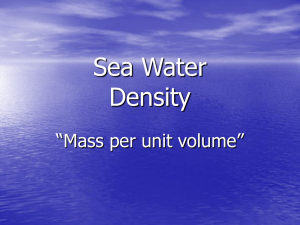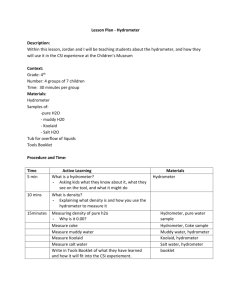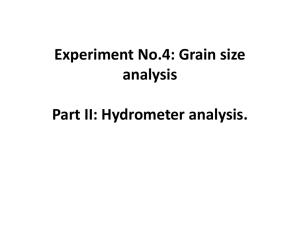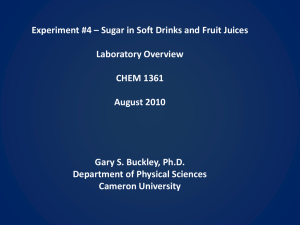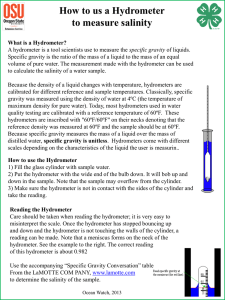SugarinSoftDrinkswithAudio
advertisement
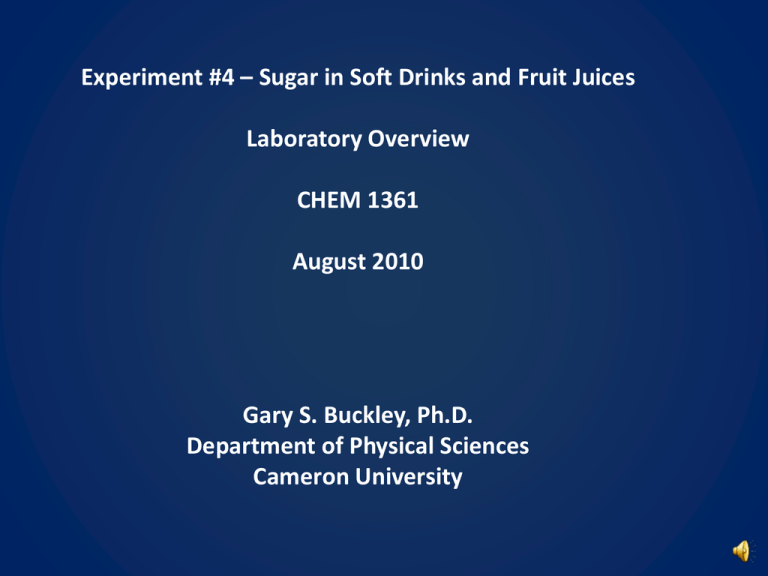
Experiment #4 – Sugar in Soft Drinks and Fruit Juices Laboratory Overview CHEM 1361 August 2010 Gary S. Buckley, Ph.D. Department of Physical Sciences Cameron University Learning Objectives •Relate density and buoyancy •Understand the relationship between sugar concentration and density •Construct a simple hydrometer •Calibrate a device and use it to make measurements •Use Excel to evaluate linear calibration data Table of Contents (you may click on any of the topics below to go directly to that topic) •Density •Archimede’s Principle •Sugar Content and Density Relationship •Straight Line Behavior •Use of calibration data to determine %sugar Density Density is the ratio of the mass of a substance or object to its volume. Mathematically: mass Density volume Hopefully this looks familiar to you by now. The principle of buoyancy and its relationship to density is used in this experiment to evaluate the concentration of sugar in various commercial drinks. As the sugar content increases, so does the density of the drink. Return to Table of Contents ↑ Archimede’s Principle The Greek scientist Archimedes, arrived at the basic principle related to flotation: An object immersed in a fluid is buoyed by a force equal to the weight of the fluid displaced by the object. The weight of the fluid displaced is related to the mass of the object (technically it is the mass of the fluid displaced multiplied by the acceleration due to gravity). In this experimental setup, the sodas and fruit juices will serve as the fluids and a constant mass device, called a hydrometer, will be floated in each. Return to Table of Contents ↑ Archimede’s Principle (continued) The hydrometer in each of these figures is the light grayed plastic pipet. Because the hydrometer has a constant mass it experiences the same gravitational force downward in each case and the upward buoyant force has to match that. In the Less Dense case, because of the lower density, a larger volume of liquid must be displaced to achieve the necessary buoyant force than in the More Dense case. Notice the different heights the hydrometer rises to in each case. Less Dense More Dense Return to Table of Contents ↑ Sugar Content and Density Relationship As the sugar concentration in an aqueous solution increases, the density of the solution increases. This physical fact may be used in conjunction with hydrometers to experimentally determine the sugar concentration in various sodas and fruit juices. As indicated on the previous slide, the height to which the hydrometer floats is related to the density, and thus sugar concentration, of the drinks. If the relationship between height and sugar concentration can be determined, the height of floating of the hydrometer may be used to find the sugar concentration. This relationship may be determined by measuring the hydrometer height in known sugar concentration solutions. This process is termed a calibration of the hydrometer. Return to Table of Contents ↑ Calibration of the Hydrometer The calibration of the hydrometer will be conducted by measuring its height of flotation in five solutions with known sugar concentrations – 0%, 4%, 8%, 12%, and 16%. Since you are building your own hydrometer, your calibration data are unique – they apply only to your hydrometer. If one draws a best line through these points it is possible to predict, for example, that a hydrometer height of 8 mm corresponds to 10% sugar. Hydrometer Height (mm) If you plot your calibration data as hydrometer height vs. % sugar (the y-axis is hydrometer height, the x-axis is %sugar), you will likely see the points fall very nearly on a straight line. Hydrometer Height vs. %Sugar 12 Such a graph may look like: 10 8 6 4 2 0 0 5 10 15 20 % Sugar Return to Table of Contents ↑ Calibration of the Hydrometer (Continued) You will use the power of an electronic spreadsheet, Excel, to accurately use your calibration data to predict the sugar contents of sodas and fruit juices. The lab book provides details about using Excel – here we just look at the mathematical parts. As the previous slide indicates, the calibration data will likely form a good straight line. Going back to your math days, you may recall the equation for a straight line is often written as: y = mx + b where m is the slope and b is the intercept. In terms of the graph on the previous slide, Hydrometer height (mm) = m × % sugar + b Application of Excel will provide the values of m and b for your hydrometer. Return to Table of Contents ↑ Determination of Sugar Content Once you have processed your calibration data, you will have an equation of the form: Hydrometer height (mm) = m × % sugar + b where you will have the values of m and b from your calibration data. Your soda and fruit juice measurements will provide hydrometer heights from which you may determine the percent sugar from: %sugar = hydrometer height(mm) - b m Return to Table of Contents ↑ The End
